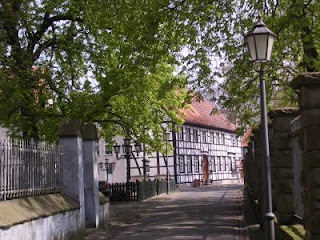Summary of project results of 11th grade students of the Freiherr-vom-Stein-GymnasiumWhat does the cultural capital have to do with industrialization? Which historical similarities and differences can be found in the comparison of the Ruhrarea and Pennsylvania (Pittsburgh)? This is the questions an eleventh grade basic course in history dealt with the last couple of weeks. Implemented to a sequence of lessons on the history of the USA, students of the Freiherr-vom-Stein-Gymnasium researched, copied, excerped and evaluated their results in small projects.
Following is a blue sheet of „small" project topics student dealt with in groups:
- Historical preconditions of industrialization and a comparison of the chronology of both industrial areas (Ruhrarea & Pennsylvania) - created by Leon Braun, Lars Binder, Felix Frühauf, René Gängler, Christian Happe, Sebastian Ratsch, Tristan Wagner and Ben Weiß
- Harkort and A. Krupp versus Carnegie and Rockefeller: What do these industrialists have in common? - created by Steffen Bertram, Manuel Gomez Garcia, Phillip Kemkes, Anton Müller, Simon Steinborn, Björn Teßmer and Erik Zemlock
- How did Germany and the USA deal with the social questions and their solutions related to industrialization? - created by Dana Hülsemann, Kathrin Kempkes, Marit Matten and Anselm-Leander Wancke
- An especially incisive cesura was the structural change in both industrial areas. How did the Ruhrarea and Pennsylvania come to terms with the new situation? - created by André Eitzer, Jörg Glowka, Michael Hußmann, Maurice Kontorowitz and Arian Kühsel
The Project results do not only show similarities, but significant differences as well. Subsequent is a very short and pointed summary of the results:
The historical conditions for the development of industrialization in Germany and the USA differed very much regarding political circumstances and mentalities of citizens. At the beginning of industrialization, Germany was coined by sectionalism and could only develop positively after abandoning it. The emancipation of the colonies from its mother country and the ending of the civil war set totally different prerequisited in the history of thought of the American people than in Germany. Rockefeller acted aggresively against strikes, Carnegie on the contrary was a prime example of a philanthrope. A. Krupp and Harkort were far more in favor of their workers than Rockefeller. The solution of the social questions during industrialization turned Germany into a welfare state, the American system only now shows approaches of social security (general health care) for all American citizens. Why were such different solutions to the social question found on both sides of the ocean? Culture, infrastructure and education are the criteria of the comparison of the industrial areas Pittsburgh and Ruhrarea. Are there more universities and bridges in the Ruhrarea or in Pittsburg? Answers to these questions can be locked up in our folder at the Freiherr-vom-Stein-Gymnasium or at the LVR-Industriemuseum in Oberhausen.
A special thank to Dana Hülsemann, Kathrin Kempkes, Marit Matten and Simon Steinborn which presented the project results at the transatlantic bridge day.Steffi Melcher (subjects: History, Psychology and German)









